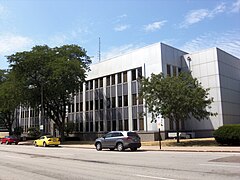Scott County Courthouse (Iowa)
| Scott County Courthouse | |
|---|---|
 |
|
| General information | |
| Type | Courthouse |
| Architectural style | Modern |
| Address | 400 W. 4th St. |
| Town or city | Davenport, Iowa |
| Country | United States |
| Coordinates | 41°31′26″N 90°34′45″W / 41.523889°N 90.579167°W |
| Construction started | 1955 |
| Completed | 1956 |
| Inaugurated | October 21, 1956 |
| Renovated | 1998-2009 |
| Cost | $1,480,000 ($13.8 million renovation) |
| Owner | Scott County |
| Technical details | |
| Floor count | 3 |
| Floor area | 84,000 square feet (7,800 m2) |
| Design and construction | |
| Architect | Arthur Ebeling (Associate Architect) |
| Architecture firm | Dougher, Rich & Woodburn |
| Main contractor | Priester Construction Co. |
The Scott County Courthouse in Davenport, Iowa, United States was built from 1955 to 1956 and extensively renovated over a ten-year period between 1998 and 2009. It is the third building the county has used for court functions and county administration. It is part of a larger county complex that includes the county jail, administration building and juvenile detention facility.
Scott County was established in 1837 by the legislature of the Wisconsin Territory. Until this time the area had been a part of Des Moines County. The first court sessions in the county were held in St. Anthony's Catholic Church. The juries met in a room that was made available by George Davenport.
Davenport and Rockingham, a town a mile south on the Mississippi River, contended for the county seat. An election was held in February 1838. Because the population base at the time was in the southern part of the county, Rockingham was favored. Davenport’s promoters paid $3,000 in whiskey and bribes to miners from Dubuque, Iowa to vote for Davenport, which won the election. Rockingham contested the election and a new election was set for August 1838. A rule was put in place whereby one had to be a resident for at least 60 days in order to vote in the election. Both towns’ promoters defrauded the ballot box this time. Laborers were imported to work in the mills at least 60 days before the election and Illinois citizens were invited to vote. When the county commissioners purged the polls after the election Davenport won by two votes. Rockingham again protested and the legislature of the Iowa Territory, of which Scott County had become a part of in 1838, set a new election for the summer of 1840.
The third election had four jurisdictions vying for the county seat. Besides Davenport and Rockingham the geographical center of the county, or “Sloperville,” entered the race as did Winfield, a town along the Mississippi near the mouth of Duck Creek. Sloperville dropped out early. The other three jurisdictions made offers of land, buildings and cash. Winfield offered 90 acres (36 ha) of land and $100 in labor and materials. Rockingham made an offer to build the courthouse and jail. Davenport’s promoters, especially Antoine LeClaire and George Davenport, promised to build a courthouse and jail free of charge. Davenport's offer of land, cash and building materials was valued at $5,000. The town also stressed its more central location and that its proposed courthouse site was on higher ground away from the Mississippi River, and therefore would not flood. Rockingham and Winfield could not match the offer and Davenport won after Rockingham withdrew on the eve of the election. The election results were celebrated in Davenport with bonfires, fireworks and speeches. Rockingham was later annexed into the city of Davenport, and Winfield is now part of Bettendorf.
...
Wikipedia
